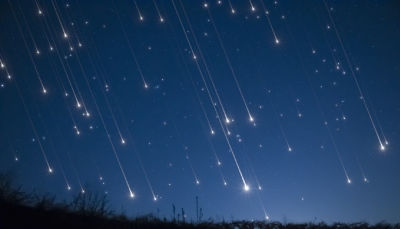
Meteor showers are named for the constellation from where they appear to emerge. For example, the Orionids meteor shower, which occurs in October every year, appears to be originating near the constellation Orion the Hunter, Perseid meteors seem to be coming from the Perseus constellation.
In some years you see more meteor showers than in others, depending on atmospheric conditions.
Astronomers sometimes find new meteor showers, like the Camelppardalis in 2014. The shower happened after the debris trail of Comet 209P/LINEAR intersected with Earth. Most meteors become visible when they come within 60 miles (96.5 km) of the Earth. On average, meteors can speed through the atmosphere at about 30,000 mph (48,280 kph) and reach temperatures of about 3,000 degrees Fahrenheit (1,648 degrees Celsius).
Let’s look at the popular meteor showers.
Leonids
The Leonids meteor shower is the brightest and most impressive one. It can produce a meteor storm that showers the sky with thousands of meteors per minute at its peak. In fact, the term “meteor shower” was copied after astronomers observed one of Leonids’ most impressive displays in 1833. The Leonids occur every November, but the shower’s most beautiful display happens at intervals of about 33 years. The last one lit up the Earth’s sky in 2002. A Leonid shower is not expected until 2028.
Perseids
Perseid may have been introduced into English from Italian Perseidi, coined by the Italian astronomer Giovanni Schiaparelli (1835-1910). Perseid ultimately comes from Greek Perseids “offspring or daughters of Perseus,” because the meteors looks like they are coming from the constellation Perseus. Perseid entered the English language in the 19th century. The Perseid meteor shower is from the comet Swift-Tuttle and happens in August. It is the most widely watched meteor shower of the year, peaking on 12 August with more than 60 meteors per minute.
Orionids
The Orionid meteor shower produces meteors from Halley’s comet, which orbits the sun every 75 to 76 years. The Orionid shower happens every October and can last for a week. It is a show of 50 to 70 shooting stars per hour at its peak.
Quadrantids
The Quadrantid meteor shower comes from the debris of an asteroid called 2003 EHI1. Astronomers believe this is part of a comet that broke apart centuries ago. The debris enters Earth’s atmosphere in early January. This meteor show is brief but spectacular.
Geminids
Like the Quadrantids, the Geminid meteor shower also came from dust particles of an asteroid called 3200 Phaeton. As the name suggests, the shower emerges from Gemini constellation. Meteor showers are mostly from comets, so having an asteroid as a parent make the Quadrantids and Geminids different from other meteor shows. The Geminids happen in December and spray up to 40 meteors per hour.
The Eta Aquarids
The Eta Aquarids is made up of the remnants of Halley’s coment. The show happens in May.
Lyrids
Lyrids, which has been written about for more than 2000 years, appears in late April.
Picture Credit : Google




